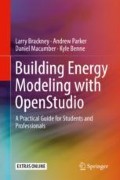Abstract
In Chap. 2 we defined the building envelope, the ambient weather conditions it is exposed to, and the interior Spaces that a building is subdivided into. Of course, the activities that take place in those Spaces are significant drivers for energy consumption as well as the reason buildings exist in the first place. In this Chapter, we will gain a better understanding of how Space occupancy and energy end uses are defined by OpenStudio. As with Constructions, the amount of data required to fully specify Space loads is significant, and we will come to appreciate how OpenStudio Libraries and data inheritance make this process both fast and consistent.
Access this chapter
Tax calculation will be finalised at checkout
Purchases are for personal use only
Change history
12 August 2018
This book was inadvertently published without the online supplementary files for chapters 2 through 9. This has now been updated accordingly.
Notes
- 1.
- 2.
Pieces of Miscellaneous Electric Equipment are sometimes referred to as “MELs” or Plug Loads .
- 3.
ASHRAE (2013).
- 4.
- 5.
- 6.
The values shown assume that you have set the Application’s units preference to English (I-P).
- 7.
District systems are heating or cooling systems that exist external to the building. Examples include central steam or chiller plants that provide heating and cooling to a campus of buildings.
References
ASHRAE (2013) Handbook fundamentals, ASHRAE, pp 18.3–18.12.
DiLaura D, Houser K, Mistrick R, Stetty G (2011) The lighting handbook, 10th edn. Illuminating Engineering Society (IES). https://www.ies.org/store/lighting-handbooks/lighting-handbook-10th-edition/
http://bigladdersoftware.com/epx/docs/8-0/input-output-reference/page-018.html#group-airflow
Author information
Authors and Affiliations
3.1 Electronic Supplementary Material
Rights and permissions
Copyright information
© 2018 Springer International Publishing AG, part of Springer Nature
About this chapter
Cite this chapter
Brackney, L., Parker, A., Macumber, D., Benne, K. (2018). Defining Energy Uses and Spaces. In: Building Energy Modeling with OpenStudio. Springer, Cham. https://doi.org/10.1007/978-3-319-77809-9_3
Download citation
DOI: https://doi.org/10.1007/978-3-319-77809-9_3
Published:
Publisher Name: Springer, Cham
Print ISBN: 978-3-319-77808-2
Online ISBN: 978-3-319-77809-9
eBook Packages: EnergyEnergy (R0)

